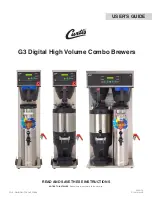
Chapter 12
LQG/H-Infinity Synthesis
Xmath Interactive Control Design Module
12-8
ni.com
Opening the LQG/H-Infinity Synthesis Window
The LQG/H
∞
window can only accept LQG
/
H
∞
controllers. If the current
controller is of type LQG
/
H
∞
(perhaps, from the History
window) and
the LQG/H
∞
window is opened, the current controller is read into the
LQG/H
∞
window; that is, the push buttons and parameters are set to the
appropriate values.
If the current controller is not of type LQG/H
∞
, and the user attempts
to open the Synthesis window, a dialog box opens and warns the user that
proceeding with opening the Synthesis
window will overwrite the current
controller (with the LQG/H
∞
controller).
The LQG/H
∞
window remembers its parameter settings, that is, when it is
opened, the parameters will be exactly as they were when the LQG/H
∞
window was last closed (or set to default values if the LQG/H
∞
window has
not been opened in this ICDM session).
Setup and Terminology
The input and output signals are distinguished in the following categories:
•
Disturbances (
ω
)
•
Actuators (
u
act
)
•
Measurements (
y
)
•
Costed outputs (
z
)
Whether an input signal is a disturbance or an actuator and whether an
output is a measurement or a costed output, is determined by the toggle
buttons in the weights window.
The objective of the control design is to minimize the expectation of the
power of (LQG), or the maximal singular value of the transfer function
from w to
z
(H
∞
). The LQG control design problem is discussed first,
followed by a discusion of how the control design is interpreted in the same
setting.
An essential part of the LQG/H
∞
formulation is the selection of (frequency
dependent) weights, control inputs, and measurements. The control design
is based on the diagram shown in Figure 12-6.
















































